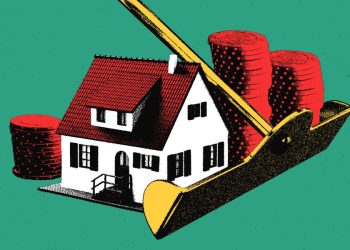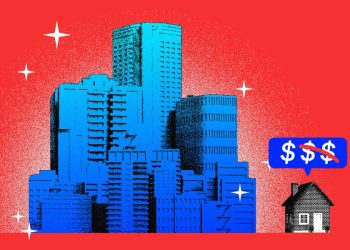About a month before I moved to Denver in 2018, I texted another recent transplant to ask for neighborhood suggestions. Her reply might as well have been in another language: Among the options she rattled off were RiNo, SoBo, LoDo, and the head-scratching LoHi. I couldn’t find those names anywhere on the city’s official maps, but the shorthand flowed freely among the youngish crowd I met there. The older real-estate types I encountered while reporting on the city’s housing market were fond of the nicknames, too. Soon I was parroting them all.
If you’ve relocated to an up-and-coming American city in the past decade, you’ve likely had to decipher a similar code. Developers and business associations have long slapped pithy names on fast-growing parts of town, and tenured residents have long rolled their eyes at them. But with the growing adoption of these new abbreviations, I think I’m ready to say enough is enough. Charlotte, North Carolina, has MoRA and LoSo; Nashville’s got SoBro; Boston has SoWa. In Louisville, Kentucky (which also has a SoBro), you may find yourself sipping a craft beer in NuLu. My hometown of Austin already has SoCo, and the powers that be are trying to make “SoLa” happen. The path of progress is paved with nonsense nomenclature — or, as my editor calls them, “‘Sound of Music’-ass names.”
These unholy mashups would be fine, I guess, if they were dumb yet harmless inventions. But they’re not just silly nicknames or low-lift marketing ploys. They’re the calling cards of developers and new arrivals as they try to wipe the slate clean on existing neighborhoods and remake them in their image. I’m all for building more housing — it’s the only way out of our affordability crisis, after all. If a goofy new name is all that’s needed to convince well-off transplants to flock to glass towers in a once deserted part of town, then great! But often it’s more about renaming a place where people already live in hopes that whitewashing its history will make it easier to attract wealthy people and drive up the property values — inevitably sending longtime residents packing.
I worry that the pandemic reshuffling, which scattered white-collar workers across the country in search of wide open spaces, will only encourage more of this kind of behavior. As cities bend over backward to attract a certain type of middle- and high-income worker, they often end up looking the same. Now they’re sounding the same, too. Let’s at least call these two-syllable monikers what they are: cookie-cutter attempts to herd HENRYs and DINKs toward new coffee shops and studio apartments in areas they would have avoided a decade ago.
It seems like every undervalued neighborhood in America is at risk of this kind of rebrand. But the SoBros and SoWas of the world are just the tip of the iceberg — the most egregious outcomes of contentious battles over neighborhoods’ names and boundaries. And unless we put our collective foot down, we’re bound to get a lot more of them.
Gill Holland moved from New York City to Louisville in 2005. Holland, a serial entrepreneur and real-estate developer, is a country boy at heart — he was born and raised in a small town in North Carolina — but he yearned for the kind of vibrant, walkable streets he’d come to love as a resident of Manhattan’s Greenwich Village neighborhood. He began renting office space at the edge of Louisville’s downtown, in a run-down area that was home to, in his words, “lots of great, old buildings.” Holland saw potential. But there was another issue. All the surrounding areas had “great brands”: strong names with history behind them, like Butchertown, Smoketown, and Phoenix Hill. Holland’s chosen zone, meanwhile, had no such calling card.
“I kept thinking, like, this part of town needs a brand,” Holland told me.
The local business association tried out “East Market District,” which stuck for a little bit. But Holland was quietly floating another name, one that represented the “New-York-to-Louisville bridge” he was already building in his mind. When he opened an art gallery in the area, he lopped off the first syllable of each city and stitched them together. The result was NuLu.
While some cities have processes for naming neighborhoods and defining their limits, most often things are more informal. Neighborhood names, as the law professors Nestor Davidson and David Fagundes noted in a 2019 paper, have long been a neat little trick of advertising devised by “real estate agents and developers, or community groups like neighborhood associations.” An apartment owner might come up with a catchy name in a bid to draw new tenants, new arrivals might will a neighborhood into existence merely by saying it a lot, or some communities might band together to intentionally reclaim an area.
These enterprising groups understand that neighborhood “brands” play an essential role in attracting new arrivals and helping them establish their place in a city (while also luring them to spend their dollars at the shops, art galleries, and restaurants in burgeoning areas). Neighborhood names are proxies for the kind of person you are or hope to become. We choose a neighborhood that matches our sense of self, the kind of place where we can find our people. Or we latch on to a neighborhood to craft a new identity, taking on the qualities of the area in which we live.
Neighborhood names are also shorthand for your rent or mortgage payments. A 2018 study from the online home-improvement platform Porch found that areas with “Hills,” “Island,” “Village,” and “Oaks” tended to have the highest household incomes across the US. Areas with the Spanish words “Los” or “Las” in their names, on the other hand, were among the neighborhoods with the lowest incomes. In another 2018 study, researchers from McGill University and the University of Maryland noted that real-estate companies relied on neighborhood boundaries to compare prices across properties and that being associated with a desirable neighborhood could improve access to things like healthcare or lower mortgage rates.
Neighborhood nicknames have a rich tradition in New York: There’s SoHo, an abbreviation for South of Houston Street (which also appears to be the inspiration for the wave of two-syllable monikers that has followed), Dumbo (Down Under the Manhattan Bridge Overpass), FiDi (the Financial District), and Tribeca (the Triangle Below Canal Street). Landlords in the city often try to stretch the boundaries of desirable neighborhoods when advertising their properties — I’ve rolled my eyes at listings that claimed to be in high-demand neighborhoods like the Lower East Side or Chelsea when no reasonable local would agree. This practice isn’t unique to New York. The researchers from McGill and Maryland found that affluent or otherwise desirable neighborhoods around the country appeared to be much larger in the eyes of landlords advertising their properties on Craigslist than they were according to less biased third parties like Google Maps or city planning departments. Meanwhile, landlords who advertised rental properties in areas with lower-income, nonwhite communities were less likely to include the neighborhood’s name in their listings.
“A single neighborhood name invokes a whole lot of different connotations or feelings for people,” Grant McKenzie, a geography professor at McGill who was a member of the research team, told me. Landlords are all too aware of this effect — mention a neighborhood that has a negative connotation, and “it immediately jumps out in the listing,” McKenzie said. The solution? Spin up new shorthand to drum up interest in an old neighborhood.
For better or worse, and I think often worse, it is a way of signaling exclusion
But here’s where things get cringey. In 2017, real-estate brokers in the historically Black New York neighborhood of Harlem sparked backlash when they tried to rebrand its south end as SoHa. Years earlier, Hakeem Jeffries, then a Democratic lawmaker in the New York State Assembly, had proposed legislation to ban neighborhood renaming, claiming the practice artificially inflated housing prices.
“Neighborhoods have a history, culture, and character that should not be tossed overboard whenever a Realtor decides it would be easier to market under another name,” Jeffries told The New York Times in 2011.
In some cases, a new neighborhood name might signal it’s already too late. Davidson told me that once a neighborhood has a lot of cachet, shortening its name, á la SoHo, can be a way of formally announcing its arrival.
“For better or worse, and I think often worse, it is a way of signaling exclusion and signaling that a certain kind of people are living in that neighborhood,” Davidson said. “That can have consequences for gentrification or displacement.”
The SoHa controversy isn’t unique to the Big Apple — in Denver, many developers proudly tout their buildings’ locations in the River North Arts District, or RiNo, without mentioning that the district is a relatively new creation overlaid on part of the historically Black neighborhood of Five Points. The South Congress strip in Austin used to be home to a brothel and porn theater; today, a visit to SoCo might include a splurge at the Hermès store or a stroll past the members-only Soho House. For developers, brokers, or whoever else is behind these rebrands, the abbreviations are a kind of compromise, McKenzie said. They’re not total erasures, but they’re clearly designed with a fresh start in mind.
“It’s an attempt to adjust things without blatantly coming in and putting a brand-new name that has nothing to do with the region,” McKenzie said. “By shortening it to this sexy acronym, you’re able to sort of mask a bit of the historical name that maybe has some negative connotation.”
Whatever the rationale behind some of these rebrands, it’s hard to argue with the results. In the case of SoCo, a thriving retail district is certainly preferable to its seedy past. Louisville’s NuLu neighborhood, which eventually caught on among other residents, has received more than half a billion dollars in investment since Holland coined the term around 2006, he told me. Bob Dylan’s whiskey company is opening a restaurant, bar, and live-music venue there. The times are indeed a-changin’.
I’m not a NIMBY. We need to build a lot more homes across all price points, and we need developers to move mountains of red tape in order to make it all happen. At their best, new neighborhood names bring people together over a shared sense of pride in their little corner of the world. But at their worst, they’re cynical chess moves designed to grease the wheels of gentrification.
Along the way, these neighborhood names have veered into parody territory. In “How I Met Your Mother,” Marshall and Lily buy an apartment in the fictional neighborhood of Dowisetrepla before realizing its name stands for Downwind of the Sewage Treatment Plant. When a “South Park” character urges his fellow citizens to revamp their town, the result is a new shopping district called SoDoSoPa. Like any good piece of satire, these names aren’t too far off from their real-life inspiration. When a Redditor posts a map of Charlotte with a reference to WeLoSo (West of Lower South End), it can be hard to tell if they’re kidding.
But while jokes at the expense of Scrabble-tile neighborhood names have been around for years, I think we’re destined to see a groundswell of new targets as pandemic-era transplants settle into their chosen Zoomtowns. I’m not saying that neighborhood names should be set in stone — in fact, I think it’s natural for them to evolve alongside their populations. But I think our cities, and their residents, deserve better than the lazy rebrands we’ve seen of late.
Recently, one X user wondered aloud whether a section of Brooklyn’s East Williamsburg neighborhood, outlined on a map in a yellow box, was worthy of a new name given its appeal to a specific kind of tech professional. The post drew some earnest comments (“East Willy!”) and plenty of backlash (“i’m begging u pls don’t make this a thing”). But one reaction, from the downtown gadfly known as Nolita Dirtbag — his own moniker a reference to the neighborhood that gets its name from a mashup of North of Little Italy — asked simply for a little introspection.
“Listen to yourself, man.”
James Rodriguez is a senior reporter on Business Insider’s Discourse team.








